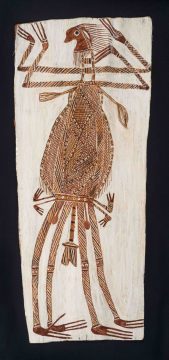Yirawala (1897-1976)


Provenance
Purchased form Sandra Holmes, Collection of Leo Kelly, Sydney; Sotheby’s June 2000, Lot 282
Essay
One of the most celebrated Australian Aboriginal artists of the twentieth century,Yirawala was a seminal figure in the contemporary bark painting movement. He was a man of high ritual authority who worked tirelessly to communicate the value of his culture to outside audiences through his art. Yirawala was the most influential of the artists in the Croker Island ‘school’ of bark painting in the 1950s and 1960s. He was a Kuninjkuritual leader with access to a vast amount of religious iconography, whose bark paintings featured the shimmering rarrk (cross-hatching) patterns of the Mardayin ceremony. With their origins in ceremonial body painting, rarrk designs are associated with the power of the Ancestor beings. Yirawala’s style of painting, which included these designs to dazzling effect, influenced many of the best-known bark painters working today.


Provenance
Purchased from Sandra Holmes, Collection of Leo Kelly, Sydney; Sotheby’s June 2000, Lot 284
Essay
One of the most celebrated Australian Aboriginal artists of the twentieth century,Yirawala was a seminal figure in the contemporary bark painting movement. He was a man of high ritual authority who worked tirelessly to communicate the value of his culture to outside audiences through his art. Yirawala was the most influential of the artists in the Croker Island ‘school’ of bark painting in the 1950s and 1960s. He was a Kuninjkuritual leader with access to a vast amount of religious iconography, whose bark paintings featured the shimmering rarrk (cross-hatching) patterns of the Mardayin ceremony. With their origins in ceremonial body painting, rarrk designs are associated with the power of the Ancestor beings. Yirawala’s style of painting, which included these designs to dazzling effect, influenced many of the best-known bark painters working today.


Mimih Ceremonylate 1960s – early 1970s
natural earth pigments on bark
52 x 23cm
Essay
One of the most celebrated Australian Aboriginal artists of the twentieth century, Yirawala was a seminal figure in the contemporary bark painting movement. He was a man of high ritual authority who worked tirelessly to communicate the value of his culture to outside audiences through his art.
Yirawala was the most influential of the artists in the Croker Island ‘school’ of bark painting in the 1950s and 1960s. He was a Kuninjku ritual leader with access to a vast amount of religious iconography, whose bark paintings featured the shimmering rarrk (cross-hatching) patterns of the Mardayin ceremony. With their origins in ceremonial body painting, rarrk designs are associated with the power of the Ancestor beings. Yirawala’s style of painting, which included these designs to dazzling effect, influenced many of the best-known bark painters working today.
Yirawala’s influence on the genre has been significant. In 1971 he was appointed a Member of the British Empire for his services to Aboriginal art. The National Gallery of Australia made a major acquisition of 139 of his paintings in 1976, and his work is held in all Australian state art collections today, as well as many important international collections. In 2013 he was one of two artists highlighted as major figures in the history of bark painting in the National Museum of Australia’s exhibition, ‘Old Masters: Australia’s Great Bark Artists’.






